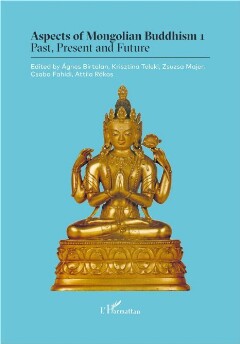

OCR
BABY CLOTHES AND OTHER POSSESSIONS OF ÖNDÖR GEGEEN DSANABADSAR The “Yurt Palace” of the Dalai Ej and its Inventory Written in 1918 D. Damdinsiiren claims that this wooden yurt “palace” (6rg6) called the Dalai éinx situated in Stiténi aimag housed the baby clothes and other belongings of Dsanabadsar. It is known from history that apart from Xandjamc, Dsanabadsar’s mother, the (Stin) Dalai éj and the Awai éj fed Dsanabadsar. Dsanabadsar gave several objects of worship to these nannies and established two rural temples (jas, Tib. spyi sa) in their honour: Caxiurtin jas in 1663 (present-day Dundgow’ province, Adacag district) for the Awai éj and Dalai &jin jas (present-day Tow province, Bayan-Onjil district) for the Dalai ej." Jawa lam Damdin (1867—1937) described the story of the temples of these two sisters in detail: Dalai jin jas was part of the /x Saw’ area governed by the Bogd himself, whilst Awai éjin jas belonged to the banner of Üijen gün. The Dalai éjin jas united with the Xotgoit Luwsan toini aimag and its name became Siiténi aimag.' Stiténi aimag was one of the first seven aimag districts Dsanabadsar founded around his residence (6rg6), and a temple was built in that aimag in honour of Mahakala, the image worshipped by Dsanabadsar’s mother (i.e. the Dalai &j). That is the reason of the district name: Siiténi aimag (Stitén ‘holy object of worship’).”° Another fact also confirms the close relation of the Bogd’s and the nannies: the Bogd’s descendants and relatives, and the Dalai &j’s descendants had a privileged area in Urga called Ondgén siirgin belcér situated between the River Til and the Middle River, behind the Green Palace.”! An archival document (National Archives of Mongolia, No. A-74, D-1, KhN—518) proves D. Damdinsiiren’s statement related to the child possessions of Dsanabadsar. It is entitled Olan-a ergtigdegsen-ti naimaduyar on qaburun segiil saradu Dalai jjiyin sitiigen-ni-dii bui Ondér gegegen-ten-ü balëir diiri-(n)ii yayum-a-yi bayicayaysan dangsa, ‘Inventory revising Ond6r gegén’s belongings from his childhood preserved in the Dalai éjin Süten written in the last month of spring in the eighth year of the One Elevated by All (1918)’. The inventory written in black ink on Chinese folded paper (25x25 cm) possesses the red, square seal of the Ministry of Ecclesiastic Affairs (Erdeni Sangjodba tan-u tamay-a-yin yajar-un temdeg) operated in Urga that governed mostly the /x Saw’ area. The four-page inventory lists pieces of clothes, ritual objects and other implements Dsanabadsar possessed.” Coinxor, J.: Öndör gegén Janabajar. Mongolian National Commission for UNESCO, Ulanbatar 1995, pp. 59-60. M. Ürintuyä translated the story of the foundation of the two temples and defended her thesis at the National University of Mongolia in 2008. Seréter, Olji: Mongolin Ix xüre, pp. 18-20. Pürew, Otgon: Mongol törin golomt. Monsudar, Ulänbätar 2004, pp. 25-29. The photograph of the whole texts was published by Enxceceg, D.: Xandjame xatni tuxai. In: Culün, S. - Mönxjargal, B. (eds): Öndör Gegen Janabajar. Am ’dral, öw. Admon Print, Ulänbätar, p. 419. 93
Szerkezeti
Custom
Image Metadata
- Kép szélessége
- 1867 px
- Kép magassága
- 2671 px
- Képfelbontás
- 300 px/inch
- Kép eredeti mérete
- 1.18 MB
- Permalinkből jpg
- 022_000084/0094.jpg
- Permalinkből OCR
- 022_000084/0094.ocr
Bejelentkezés
Magyarhu
